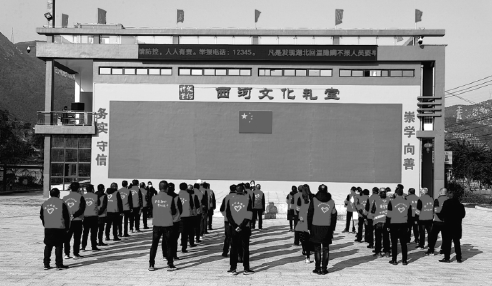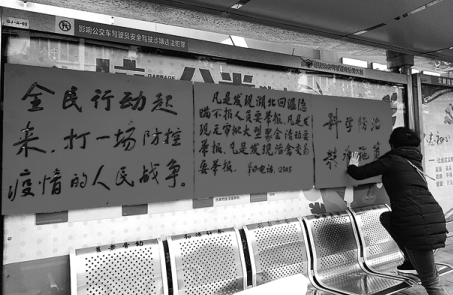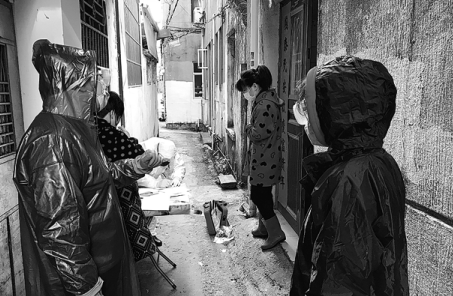Local art form aims to raise awareness
Auditoriums for cultural activities are bringing people together, Xu Xiaodan, Ma Zhenhuan and Qin Jirong report from Wenzhou, Zhejiang province.

Many auditoriums in Zhejiang province, constructed in recent years to host cultural programs, have turned into places from where locals are helping the fight against the novel coronavirus.
In Wenzhou, a city in Zhejiang with more than 300 confirmed cases of infection as of Wednesday, the management team of the local cultural auditorium is coordinating efforts of officials, rural residents and volunteers in disease control and prevention.
Dozens of teams were formed within few days to post notices on bulletin boards of auditoriums, tell villagers about the dos and don'ts during the period, register people from Hubei, distribute face masks and control the entry and exit of vehicles and individuals.
"I get more than 300 phone calls every day. We are trying our best to curb the spread of the virus on our island," says Huang Jianfeng, a volunteer from Ximen in Yueqing, a county-level city in Wenzhou, which reported 75 confirmed cases of infection as of Sunday.
Meanwhile, guci, a ballad, and slogans are being used to alert senior villagers to the epidemic. Chen Dehua, who is in charge of the cultural auditorium in Huling town of Ruian, another county-level city in Wenzhou, composed lyrics about preventive measures for a guci show on Jan 26 to increase awareness among the elderly. The ballad, titled Health is a Blessing, is now played by the broadcasting stations in Ruian.
People in rural areas of China didn't have modern facilities to enjoy cultural activities and there were not many proper venues to mobilize people in public events such as healthcare campaigns in the past before the auditoriums were built.
Zhejiang, an economic powerhouse in East China, began to build cultural auditoriums in 2013, when the per capita net income of farmers in the province had secured the top place nationwide yet again. The provincial government began to pay attention to the cultural life of rural residents as daily public requirements became broader.
In the same year, the province launched a drive to build cultural auditoriums in Zhejiang's villages and included it in the "10 must-do things for the people". In 2019, the province had 3,282 new cultural auditoriums and by the end of last year, the number had crossed 14,300. Aimed at showcasing local culture, most such venues were constructed in accordance with local conditions. They are not just grand halls for performances or meetings but also bases for diverse activities.
Yangzhai village in Wenzhou's Ouhai district is a cradle of guci. Since a cultural auditorium was built there in 2013, the art form has been regenerated through better inheritance and development. Every month, there are four guci performances staged in the auditorium, attracting hundreds from the village and its neighboring areas to gather at the 1,800-square-meter hall, Jiang Yuzhou, Party chief of Yangzhai, says.
"The older generations in Wenzhou have a deep affection for traditional folk art," he tells China Daily."We hope to provide entertainment for the elderly, and also promote guci culture among young generations via activities in the auditorium."
Many overseas Chinese have roots in Yangzhai and are fond of guci, which Jiang says will help in its inheritance and development.
Zishang village in Wenzhou, just 4 kilometers away from Yangzhai, has more than 3,000 villagers working and living abroad nowadays. Some of them are overseas migrants, and some are working or living there temporarily. Foreign influence is seen in the village's auditorium that was constructed in 2017, such as a Western restaurant and an exhibition and sales room for imported goods. There were many vacant houses due to villagers moving out, Jin Yongyong, Party secretary of Zishang, says.
After the completion of the auditorium, he drew a blueprint of a modern complex for culture, tourism and entertainment with the auditorium at the center, and made a plan to attract business and investment. With the support of overseas Chinese, with origins in the village, tourism resources, including a flower field, a restaurant and a Westernstyle street began to spring up in Zishang, and the auditorium has been given a new role-the service center for tourists.
Jin says in future he plans to apply advanced technologies such as 5G and facial recognition in the village's management and operation in a bid to build Zishang into a "modern village with international hues".
Seeing how cultural auditoriums are changing their daily life, people in Zhejiang have shown a growing zeal for public affairs and a stronger sense of belonging.
Hou Yuexiang is one of the volunteers in Qingnianfang community of Wenzhou. Besides offering care and love to neighbors through voluntary services, the 70-year-old and her 85 peers make up a team in charge of the daily management of the community's cultural auditorium.
"The auditorium, along with a library and a gym, were built for us and the activities enrich our cultural life," says Hou," which makes it necessary to ensure the orderly operation of these facilities by ourselves."
She adds: "As a volunteer, I am so glad to see that people from the community, young and old, appreciate and enjoy our services in the auditorium."
Chen Chaonan, a resident of Nan'ao village in Ruian, says she and her children are frequent visitors to the local cultural auditorium. "People of all ages are able to have fun there due to the multiple choices for entertainment, including chess games, toys, books and fitness equipment."




Today's Top News
- Ukraine says latest peace talks with US, Europe 'productive'
- Asia's rise and Europe's structural decline
- Economic stability a pillar of China's national security
- Xi taps China's deep wisdom for global good
- New rules aim for platforms' healthy growth
- Chinese web literature grows overseas






























